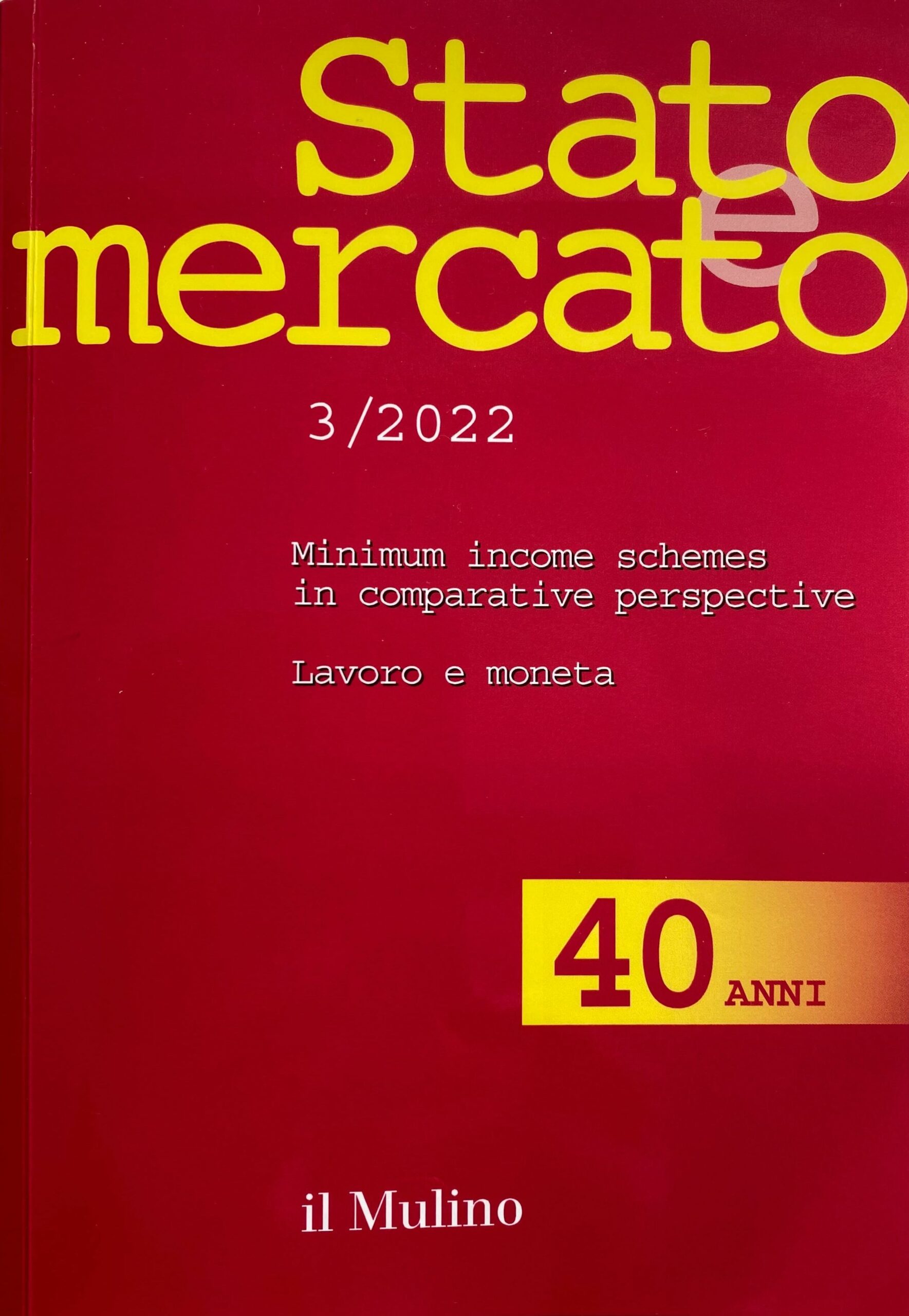| This article is also available in Italian |
The 3/2022 issue of Stato e Mercato, a Il Mulino Journal that explores the relationship between economics and institutions from a comparative and interdisciplinary perspective, presents a thematic session on minimum income schemes in comparative perspective articulated in three contributions in English that – combining different disciplinary perspectives – address the issue of combating poverty. The papers, starting with an analysis of the Citizenship Income, identify some issues worthy of further investigation, also through comparison with other anti-poverty protection schemes. These contributions thus provide useful insights into the characteristics of the Italian measure and, more generally, into the ongoing debate, which is also fueled by anticipations of the new Active Inclusion Measure (MIA – Misura di Inclusione Attiva) proposed by the Meloni Government.
Community service projects and Minimum Income Schemes
The first article, by Rosangela Lodigiani e Franca Maino, is entitled “Minimum income, active inclusion, and work requirements in Europe: Insights from community service projects introduced by Italian Citizenship Income”. Italian community service projects (Progetti utili alla collettività, PUCs) constitute a key component of Italian Citizenship Income (Reddito di Cittadinanza, RdC) which – although the name implies an unconditional measure – has put beneficiary activation at the core of the Italian anti-poverty strategy. The RdC is a means-tested cash benefit, with several activation and conditionality requirements, depending on the beneficiaries’ (in)ability to work. Except for those exempt under the law, all RdC beneficiaries are required to consent to join PUCs under penalty of forfeiture of the subsidy.
PUCs thus represent an activation requirement similar to those that have been spreading in the European minimum income schemes (MISs), particularly since the launch of the Lisbon Strategy and the consequent “activation turn”. However, the Italian legislation specifies that PUCs are not only an obligation but also “an opportunity for inclusion and growth” for the beneficiaries and the local communities, according to a perspective of empowerment regarding the beneficiaries and community development. Given this twofold value (required counter-performance and empowerment), PUCs are particularly interesting in the European landscape, where similar mandatory unpaid work experience or public work for MIS recipients is quite uncommon and little studied.
This article aims to help reduce this knowledge gap by examining the PUC experience in light of the international literature on active inclusion and other community service experiences in Europe. In addition, through qualitative empirical research, this article enters the black box of PUC implementation at the local level by investigating which factors are preventing – or promoting – their efficient functioning.
Monetary poverty and adequacy of minimum income schemes in comparative perspective
The second paper, “Monetary poverty and adequacy of minimum income schemes in seven major EU countries: What linkages?“, was written by Massimo Aprea, Giovanni Gallo, and Michele Raitano. The European Commission defines an official poverty indicator (AROP – At Risk of Poverty rate) that identifies as poor those individuals with a disposable income lower than the poverty line, set at 60% of national equivalized median disposable income.
However, when establishing entitlement criteria to access Minimum Incom Schemes (MIS), EU Member States often adopt their own (more or less implicit) poverty definitions. Usually, these definitions are loosely related or wholly unrelated to the EU-level official poverty line. For instance, these “administrative” poverty definitions are unrelated to the AROP concept when they are based on reference budgets, absolute poverty lines, indexes about the cost of living, or existing social protection minima. Moreover, even when implicitly following criteria similar to the AROP indicator, countries may establish additional criteria (e.g., in terms of wealth endowment or personal characteristics, such as age or citizenship) that prevent individuals with an income below the poverty line from accessing the MIS.
This article analyzes, in terms of benefit adequacy and a comparative perspective, the relation between the administrative poverty concepts implied by income eligibility requirements to minimum income schemes and the «at-risk-of-poverty» (AROP) indicator. To this aim, the authors focus on seven major EU countries: Italy, Germany, Spain, France, Sweden, Ireland, and Poland. Once described the eligibility requirements for minimum income benefits applied in these countries, they empirically investigate the relationship between the values of the AROP lines and the (implicit) poverty administrative lines for various household types.
The nexus between in-work benefits and minimum income schemes
The latest article, “Make them work! In-work benefits after the pandemic in the reform of Italy’s minimum income scheme“, written by Andrea Ciarini, Matteo Luppi e Stefano Sacchi addresses the issue of so-called in-work benefits (IWBs). IWBs can be defined as direct earnings subsidies, tax credits, or equivalent work-related benefits aimed at alleviating in-work poverty and increasing work-contingent benefits aimed at alleviating in-work poverty for low-income workers and their families.
Due to the pandemic, the linkage between in-work benefits and Minimum Income Schemes (MIS) is likely to gain prominence due to the potential impact of asymmetric employment shocks on low-income workers. Framing the characteristics of IWBs in the institutional setting and the functioning of the welfare state in several European countries, this article draws lessons for the Italian case on the role of these measures in avoiding poverty traps. Using EU-LFS data and INAPP Plus data, the authors analyze, in the Italian case, the variation before and after the pandemic outbreak in the profiles of MIS beneficiaries close to the labour market and of those workers who have become unemployed.
Evidence indicates that the variations in the profiles of MIS beneficiaries and those transitioning into unemployment after the pandemic outburst call for a fully-fledged IWB. This should be properly linked with MIS to minimize the risks of a poverty trap and encourage the take-up of regular employment. Rather than dismantling MIS support for the “employable” recipients, evidence suggests that reform should focus on making MIS compatible with work through the IWB schemes.
